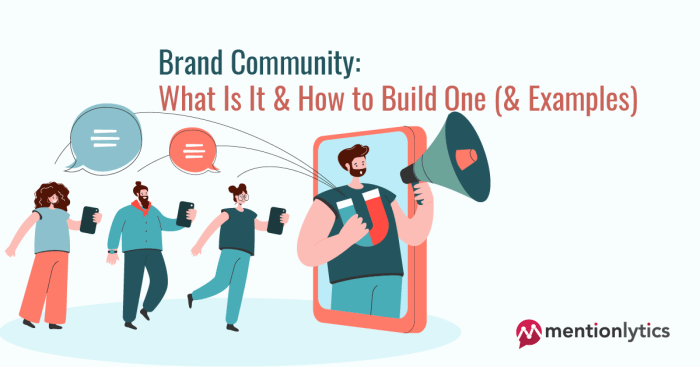Building an Online Brand Community sets the stage for businesses to thrive in the digital world, cultivating strong connections and loyalty among customers. Get ready to dive into the dynamic realm of online branding!
In today’s digital age, creating a virtual space where customers feel valued and engaged is essential for any brand looking to make a lasting impact.
Importance of Building an Online Brand Community
Building an online brand community is crucial for business growth in today’s digital age. It allows companies to connect with their customers on a deeper level, fostering a sense of belonging and loyalty.
Enhancing Customer Loyalty and Engagement
An online brand community can enhance customer loyalty by creating a space where customers feel valued and heard. By engaging with the brand and other community members, customers develop a stronger connection to the brand, leading to repeat purchases and positive word-of-mouth recommendations.
- Companies like Apple have successfully built online brand communities through their forums and social media platforms. These communities provide a space for customers to share their experiences, ask questions, and connect with other Apple enthusiasts. This engagement not only strengthens customer loyalty but also helps Apple gather valuable feedback for product improvements.
- Another example is Sephora’s Beauty Insider Community, where makeup enthusiasts can share tips, reviews, and product recommendations. This community has helped Sephora create a loyal customer base that actively participates in discussions and interacts with the brand online.
Strategies for Building an Online Brand Community

Building an online brand community from scratch requires a strategic approach to engage and connect with your target audience. Here are the key steps involved in creating a successful online brand community:
Choose the Right Platform
- Consider the goals of your brand community and choose a platform that aligns with your objectives. Platforms like Facebook, LinkedIn, or dedicated community forums offer different features and functionalities.
- Pros of popular platforms:
- Facebook: Wide reach and engagement potential.
- LinkedIn: Professional networking and B2B opportunities.
- Community Forums: Customization and focused discussions.
- Cons of popular platforms:
- Facebook: Algorithm changes affecting organic reach.
- LinkedIn: Limited customization options.
- Community Forums: Requires active moderation and management.
Create Engaging Content
- Develop a content strategy that resonates with your audience and encourages participation.
- Utilize a mix of formats such as videos, polls, and interactive posts to keep community members engaged.
- Encourage user-generated content to foster a sense of ownership among community members.
Promote Your Community
- Utilize social media channels, email marketing, and partnerships to promote your brand community.
- Collaborate with influencers or industry experts to expand your reach and credibility.
- Offer exclusive perks or incentives for community members to encourage growth and retention.
Engaging Members in an Online Brand Community

To keep members active and engaged in an online brand community, it’s essential to provide opportunities for participation, foster a sense of belonging, and create a positive environment where users feel valued. Here are some methods to encourage active engagement within your brand community:
Creating Meaningful Interactions
- Encourage members to share their experiences, feedback, and ideas related to your brand.
- Organize contests, polls, and challenges to spark interest and participation.
- Host live events, webinars, or Q&A sessions to interact with members in real-time.
Moderation and Community Guidelines, Building an Online Brand Community
Establish clear community guidelines to set expectations for behavior and content. Moderators play a crucial role in enforcing these guidelines to maintain a positive and respectful environment within the community. By monitoring discussions, addressing conflicts, and removing inappropriate content, moderators can ensure that the community remains a safe space for all members.
Leveraging User-Generated Content
- Encourage members to create and share content such as reviews, testimonials, and user-generated videos.
- Showcase user-generated content on your brand’s social media channels or website to highlight the contributions of community members.
- Reward and recognize active participants by featuring their content, offering exclusive perks, or hosting member spotlights.
Measuring Success and ROI of an Online Brand Community
Building and maintaining an online brand community requires continuous effort and resources. It is essential to measure the success and return on investment (ROI) of these communities to ensure that they are adding value to the brand. Tracking key metrics, analyzing data, and gathering feedback are crucial steps in evaluating the performance of an online brand community.
Key Metrics to Track
- Engagement Rate: Measure the level of interaction and participation within the community.
- Membership Growth: Track the number of new members joining the community over time.
- Retention Rate: Monitor how many members continue to stay active in the community.
- Customer Satisfaction: Collect feedback from members to gauge their satisfaction with the community experience.
Analyzing Data and Feedback
Once key metrics are tracked, it is important to analyze the data and feedback to identify areas for improvement and optimization.
- Use sentiment analysis tools to understand the overall sentiment of community members towards the brand.
- Segment data based on demographics or behavior to tailor community initiatives to specific groups.
- Monitor trends and patterns in member activity to anticipate future needs and preferences.
Tools for Measuring ROI
There are various tools and software available to help measure the ROI of an online brand community.
-
Google Analytics: Track website traffic, user behavior, and conversion rates within the community.
-
Social Media Analytics: Monitor social media engagement and referral traffic from social platforms to the community.
-
Community Management Platforms: Utilize platforms like Lithium or Salesforce Community Cloud to track community metrics and performance.












